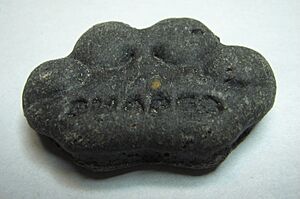Charcoal biscuit facts for kids

A charcoal biscuit is a special type of biscuit that gets its unique look and some of its properties from charcoal. It's made by mixing powdered willow charcoal or activated carbon with regular flour. Just like other biscuits, it's then turned into dough with ingredients like butter, sugar, and eggs. These biscuits are often dark in color, sometimes even black, because of the charcoal inside them.
A Look Back: History of Charcoal Biscuits
Charcoal biscuits first appeared in England during the early 1800s. People back then started making them to help with tummy issues like flatulence (gas) and general stomach discomfort.
Old medical books from that time, like The Retrospect of Practical Medicine and Surgery published in 1856, suggested using charcoal biscuits for stomach problems. They even mentioned that each biscuit had about 648 milligrams of charcoal. Another book from 1857, called Vegetable Charcoal, said these biscuits were a great way to give charcoal to children who needed it for their digestion.
Charcoal Biscuits Today
Today, charcoal biscuits are still around, but they're often used differently. Many are made as crackers. These crackers are popular to eat with various cheeses. Some people find the slight charcoal taste in them quite enjoyable.
You might also find charcoal biscuits sold as products for pets. They are sometimes given to dogs and other animals to help control gas or aid their digestion. For humans, they are still sometimes marketed as a way to help with digestion or stomach problems.

